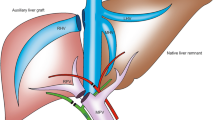Abstract
Background. Auxiliary partial orthotopic liver transplantation (APOLT) has been developed in order to benefit from the efficacy of orthotopic liver transplantation (OLT) in the treatment of fulminant hepatic failure (FHF), but to avoid the negative counterpart of OLT which is to eliminate the possibility of native liver (NL) regeneration and which consequently implies a life-long immunosuppression.Methods. In our institution we performed 16 consecutive APOLTs in 15 patients between October 1992 and December 1999. Patients’ mean age was 30 years (range 0.5–65 years). The causes of FHF were viral (HAV = 3; HBV = 3), drugs (n = 4), or others (n = 5). None of the patients had a history of chronic liver disease. The decision to transplant was taken when the patients met well-defined criteria. All but one of the patients were in a coma.Results. Five patients died, 10 patients are alive (66.7%). Regeneration of the NL occurred in 11 of the 15 patients (73.3%) and in 8 of the 10 survivors. Six of these 8 patients have permanently stopped immunosuppressive therapy. These results can be favorably compared with those of OLT for FHF. In the European Transplant Registry, the survival rate is 57% at 5 years (2612 patients receiving OLT for FHF between 1988 and 1998). In our experience the survival rate is 59% at 5 years (42 patients receiving OLT for FHF between 1987 and 1999).Conclusions. APOLT is feasible in both adults and children; it rapidly restored liver function and reversed encephalopathy. Right APOLT seems more advisable since the right liver provides more functional hepatocytes; however, left APOLT harvested in an adult appears sufficient for a child. APOLT should be proposed only to patients with high chances of liver regeneration: age of recipient, etiology of liver failure, interval between onset of jaundice and occurrence of encephalopathy, and quality of liver graft are early prognostic indicators. Better results have been observed with younger patients (less than 40 years old) presenting with FHF (rather than subfulminant hepatic failure (SHF)) and due to HAV, HBV, or paracetamol.
Similar content being viewed by others
References
Bismuth H, Samuel D, Castaing D, Adam R, Saliba F, Johann M, et al. Orthotopic liver transplantation in fulminant and subfulminant hepatitis. The Paul Brousse experience. Ann Surg 1995; 222: 109–19.
Terpstra OT, Schalm SW, Weimar W, Willemse PJA, Baumgartner D, Groenland THN, et al. Auxiliary partial liver transplantation for end-stage chronic liver disease. N Engl J Med 1988; 319: 1507–11.
Metselaar HJ, Hesselink EJ, De Rave S, Ten Kate FJ, Lameris JS, Groenland TH, et al. Recovery of failing liver after auxiliary heterotopic transplantation. Lancet 1990; 335: 1156–7.
Moritz MJ, Jarrell BE, Munoz SJ, Maddrey WC. Regeneration of the native liver after heterotopic liver transplantation for fulminant hepatic failure. Transplantation 1993; 55: 952–5.
Stampfl DA, Munoz SJ, Moritz MJ, Rubin R, Armenti VT, Jarrell BE, et al. Heterotopic liver transplantation for fulminant Wilson’s disease. Gastroenterology 1990; 12: 1834–8.
Gubernatis G, Pichlmayr R, Kemnitz J, Gratz K. Auxiliary partial orthotopic liver transplantation (APOLT) for fulminant hepatic failure: first successful case report. World J Surg 1991; 15: 660–6.
Boudjema K, Jaeck D, Siméoni U, Bientz J, Chenard MP, Brunot B, et al. Temporary auxiliary liver transplantation for acute liver failure in a child. Lancet 1993; 342: 778–9.
Boudjema K, Cherqui D, Jaeck D, Chenard-Neu MP, Steib A, Freis G, et al. Auxiliary liver transplantation for fulminant and subfulminant hepatic failure. Transplantation 1995; 59: 218–23.
Chenard-Neu MP, Boudjema K, Bernuau J, Degott C, Belghiti J, Cherqui D, et al. Auxiliary liver transplantation: regeneration of the native liver and outcome in 30 patients with fulminant hepatic failure. A multicenter European study. Hepatology 1996; 23: 1119–27.
Sudan DL, Shaw BW, Fox IJ, Laugnas AN. Long-term follow-up of auxiliary orthotopic liver transplantation for the treatment of fulminant hepatic failure. Surgery 1997; 122: 771–8.
Higashiyama H, Yamaguchi T, Mori K, Nakano Y, Yokoyama T, Takeuchi T, et al. Graft size assessment by preoperative computed tomography in living related partial liver transplantation. Br J Surg 1993; 80: 489–92.
Whitington PF, Emond JC, Heffron T, Thistlethwaite JR. Orthotopic auxiliary liver transplantation for Crigler-Najjar syndrome type 1. Lancet 1993; 342: 779–80.
Uemoto S, Yabe S, Inomata Y, Nishizawa H, Asonuma K, Egawa H, et al. Coexistence of a graft with the preserved native liver in auxiliary partial orthotopic liver transplantation from a living donor for ornithine transcarbamylase deficiency. Transplantation 1997; 63: 1026–8.
Sakahara H, Kiuchi T, Nishizawa S, Saga T, Nakamoto Y, Sato N, et al. Asialoglycoprotein receptor scintigraphy in evaluation of auxiliary partial orthoptic liver transplantation. J Nucl Med 1999; 40: 1463–7.
Rela M, Muiesan P, Vica-Melendez H, Dhawan A, Baker A, Mieli-Vergani G, et al. Auxiliary partial orthotopic liver transplantation for Crigler-Najjar syndrome type 1. Ann Surg 1999; 229: 565–9.
Inomata Y, Kiuchi T, Kim ID, Uemoto S, Egawa H, Asonuma K, et al. Auxiliary partial orthotopic living donor liver transplantation as an aid for small-for-size grafts in larger recipients. Transplantation 1999; 67: 1314–9.
Author information
Authors and Affiliations
Rights and permissions
About this article
Cite this article
Jaeck, D., Boudjema, K., Audet, M. et al. Auxiliary partial orthotopic liver transplantation (APOLT) in the treatment of acute liver failure. J Gastroenterol 37 (Suppl 13), 88–91 (2002). https://doi.org/10.1007/BF02990107
Issue Date:
DOI: https://doi.org/10.1007/BF02990107




